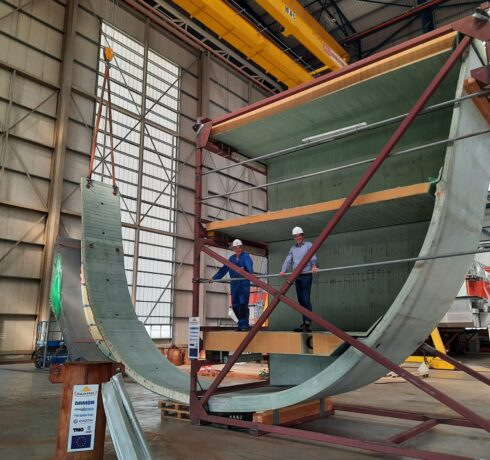The application of sustainable composite materials as an alternative to steel in the production of large commercial ships has come a step closer. This is what Marcel Elenbaas had to say after the successful construction of a piece of composite hull at Damen Schelde Naval Shipbuilding.
On September 15 in Assembly Hall 2 in Vlissingen-East, a six-metre high hull section made entirely from a composite material was installed on an 85-metre offshore patrol vessel. The initiative was part of RAMSSES, a European project involving 35 different companies and organisations, including Damen and other shipyards. The project aims to demonstrate the viability of building large composite ships as a means to make international shipping more sustainable.
“At DSNS, in cooperation with a number of partners, we have been able to demonstrate the feasibility of fabricating a complete composite hull at a shipyard that usually uses steel,” says Marcel, Senior Engineer at Research & Technology Support at DSNS. “Because of Covid-19, we could not have anyone physically present at the demonstration, but thanks to a livestream, 150 project participants across Europe could follow the event directly.”
“The material is almost half the weight of steel."
“Last July, DSNS in Vlissingen-Oost already demonstrated that it was possible to assemble a piece of composite hull under normal shipyard conditions. But on September 15, the entire production process of a hull took place at the same location. This proves that it was possible to vertically infuse thick laminates with resin up to a height of six metres.” The company InfraCore, specialist in the application of composites in roads and bridges, provided the resin infusion. This process involves sucking the resin through the fibres of the composite.
Building composite ships is a step towards a more sustainable world, says Marcel. “The material is almost half the weight of steel. This reduces fuel consumption, so you can equip the ship with lighter engines. Moreover, a composite ship requires less maintenance. Due to the reduced fuel consumption, the ship emits less CO2. And because you have smaller engines, there is more space on board, so you can come up with smarter ship designs by combining certain functions or adding additional systems. In short, the ability to create a more versatile platform. The application of composites therefore has major consequences for the entire ship design.”
While Damen has previously built 24-metre long waterbuses (ferries) from composites, the RAMSSES project (which stands for: Realization & Demonstration of Advanced Material Solutions for Sustainable and Efficient Ships) specifically aims to increase the feasibility of composite construction for longer and higher commercial vessels. This refers to ships longer than 85 metres and at least six metres high. Marcel: “I think we have taken a good step forward. Project RAMSSES, which receives funding from the European Union, hopes to convince the International Maritime Organization (IMO) and regulators that large-scale composite construction in commercial shipbuilding is responsible, commercially viable for our customers, and contributes to a cleaner world. As DSNS, we can deliver these types of ships on time and on budget.”
In addition to DSNS and InfraCore, the project in Vlissingen-Oost also involved Evonik, Airborne, Bureau Veritas, TNO and Netherlands Maritime Technology.

